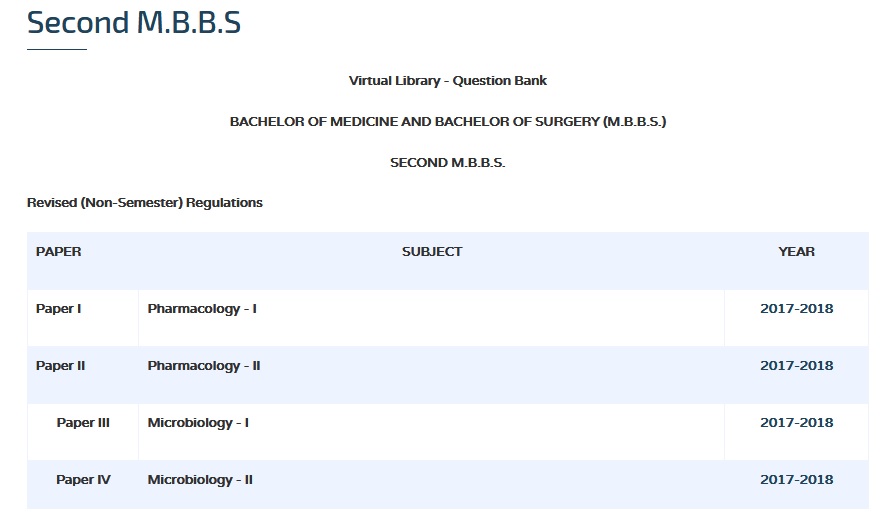General Microbiology, Immunology & Systematic Bacteriology MBBS Question Bank : web.tnmgrmu.ac.in
Name of the University : The Tamilnadu Dr. M.G.R. Medical University
Degree : Second M.B.B.S
Subject Code/Name : 4061 General Microbiology, Immunology & Systematic Bacteriology
Paper : I
Document Type : Question Bank
Website : https://www.tnmgrmu.ac.in/index.php/library/e-questions.html
TN MGRMU General Microbiology Question Paper
August 2008 :
I. Essay Questions : (2 x 15 = 30)
1. Define and classify sterilization. Write about sterilization by moist heat.
Related / Similar Question Bank :
TNMGRMU MBBS Pharmacology Question Bank
2. Mention the bacterial agents causing meningitis. Discuss the pathogenesis and laboratory diagnosis of acute pyogenic meningitis caused by any one of them. .
II. Write Short notes on : (10 x 5 = 50)
1. Atypical mycobacteria.
2. Tests for toxin production of coryne bacterium diphtheria.
3. Bacterial Virulence.
4. Gonorrhoea.
5. Immunoglobulin G.
6. Biological functions of complement.
7. Bacterial Capsule.
8. Widal test.
9. Type III Hypersensitivity.
10. Non suppurative complications of streptococci.

III. Short Answer Questions : (10 x 2 = 20)
1. Name four pigments produced Bacteria.
2. Diagram of Immunoglobulin M.
3. Give four examples of enriched media.
4. Name two zoonotic bacterial diseases.
5. Tube coagulase test.
6. Name four specific serologic tests for syphilis.
7. Four differences between exotoxin and endotoxin.
8. Two liquid media to grow Mycobacteria.
9. Sattelitism.
10. Urease test.
February 2009
I. Essay Questions : (2 x 15 = 30)
1. Describe the morphology of the bacterial cell with the help of a neat diagram and mention the function of various appendages.
2. Name the bacteria causing sexually transmitted disease. Discuss the laboratory diagnosis of syphilis.
II. Write Short notes on : (10 x 5 = 50)
1. Hot air oven.
2. Nocardia.
3. Non-sporing Anaerobic infection.
4. Passive immunity.
5. Mycoplasma (lab diagnosis).
6. Louis pasteur.
7. Active immunity.
8. E1 – Tor vibrios.
9. Graft versus host reactions
10. Helicobacter pylori.
III. Short Answer Questions : (10 x 2 = 20)
1. Negative staining.
2. Give two examples for transport media.
3. Arthus phenomenon.
4. Nagler’s reaction.
5. Cold sterilization.
6. Two uses of HLA Typing.
7. Oxidase test.
8. Name the three special species of Brucella.
9. Mantoux test.
10. X and V factors
August 2009
I. Essay Questions : (2 x 15 = 30)
1. Define and classify sterilization. Write in detail about chemical methods of sterilization.
2. Name the bacterial agents causing pyrexia of unknown origin. Write the pathogenesis and lab diagnosis of enteric fever.
II. Write Short notes on : (10 x 5 = 50)
1. Flagella.
2. Transduction.
3. Acquired immunity.
4. Monoclonal antibodies.
5. Coagulase test.
6. Elek’s gel precipitation test.
7. VDRL test.
8. Autoclave.
9. Lepromin test.
10. Weil felix test.
III. Short Answer Questions : (10 x 2 = 20)
1. Pasteurisation.
2. Koch’s postulates.
3. Name four selective media.
4. Plasmids.
5. Name four mechanisms of auto immunity.
6. Neufeld quelling phenomenon.
7. M¹ fadyean’s reaction.
8. Name four clostridia causing gas gangrene.
9. Stalactite growth.
10. Runyons classification of atypical mycobacteria.
February 2010
I. Essay Questions : (2 x 15 = 30)
1. Define and classify hypersensitivity reactions. Describe type I hypersensitivity.
2. Describe the pathogenesis, laboratory diagnosis and prophylaxis of cholera.
II. Write Short notes on : (10 x 5 = 50)
1. Halophilic vibrio.
2. Bacterial capsule.
3. Hot air oven.
4. Conjugation.
5. Malignant pustule.
6. IgE.
7. Adjuvant.
8. Bacterial growth curve.
9. Tric agent.
10. Widal test.
III. Short Answer Questions : (10 x 2 = 20)
1. Satellitism.
2. Milk ring test.
3. Enriched media.
4. Nagler’s reaction.
5. Classification of atypical mycobacteria.
6. Hapten.
7. Name four methods of dry heat sterilization.
8. Name three anaerobic media.
9. Mention three properties of exotoxin.
10. Four organisms causing nosocomial infection.
August 2010
I. Essay Questions : (2 x 15 = 30)
1. Define and classify Antigen Antibody reactions. Discuss Agglutination tests with clinical examples.
2. Enumerate sexually transmitted bacteria. Discuss Pathogenesis and laboratory diagnosis of Syphilis.
II. Write Short notes on : (10 x 5 = 50)
1. Capsule.
2. T cells and B cells.
3. Mutation.
4. Extra chromosomal genetic elements.
5. Mechanism of Autoimmunity.
6. Nosocomal infections.
7. Type IV Hypersensitivity.
8. Laboratory diagnosis of pulmonary tuberculosis.
9. Toxigenicity tests for coryne bacterium diphtheria.
10. Differences between Alpha haemolytic streptococci and pneumococci.
III. Short Answer Questions : (10 x 2 = 20)
1. Name four bacteria causing food poison.
2. Inspissation.
3. Super Antigens.
4. Name four Anaerobic methods of cultivation.
5. C – Reactive protein.
6. Hot Air Oven.
7. Sterilization of operation theatre.
8. Graft versus host reaction.
9. Name four live bacterial vaccines.
10. Uses of Gram stain.
February 2011
I. Essay Questions : (2 x 15 = 30)
1. Define sterilization and disinfection. Discuss the methods of sterilization by moist heat with suitable examples.
2. Enumerate the bacteria causing diarrhoea. Discuss the morphology, cultural characteristics, pathogenecity and laboratory diagnosis of Vibrio cholera.
II. Write Short notes on : (10 x 5 = 50)
1. Fimbriae.
2. Immuno fluorescence methods.
3. Sources of human infection.
4. Cytokines.
5. Distinguishing factors of T and B lymphocytes.
6. Biochemical tests to identify mycobacterium.
7. Human Leukocyte Antigen (HLA).
8. Toxins and virulence factors of streptococci.
9. Enterotoxigenic Escherichia Coli (ETEC).
10. Listeria monocytogens.
III. Short Answer Questions : (10 x 2 = 20)
1. Name four anaerobic bacteria.
2. Name four chemical methods of sterilization.
3. Enrichment media.
4. Features of transferable drug resistance.
5. Diagram of Immunoglobulin.
6. Name four combined (T & B cell) immunodeficiency disorders.
7. Name four non-organ specific auto immune disorders.
8. Louis Pasteur.
9. Etiology of non-gonococcal (non-specific) urethritis.
10. Mention the various types of hypersensitivity reactions.
Download Model/Sample Question Paper :
2008-2014 :https://www.pdfquestion.in/uploads/we…5-524061LA.pdf
2001-2008 : https://www.pdfquestion.in/uploads/we…5-524061KU.pdf
2000 :https://www.pdfquestion.in/uploads/we…5-524061KC.pdf